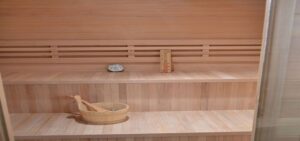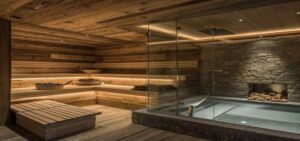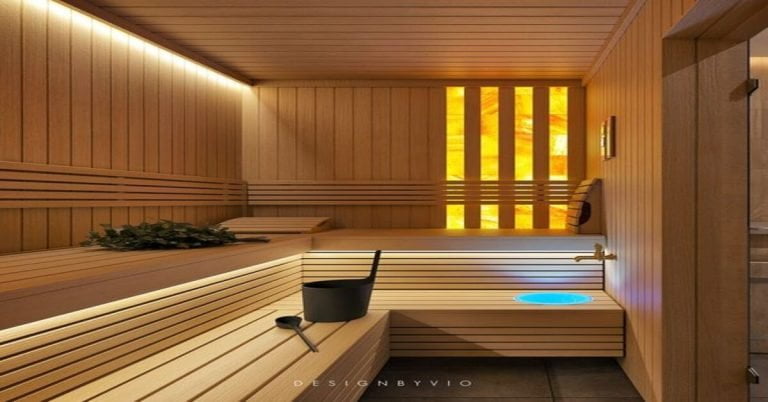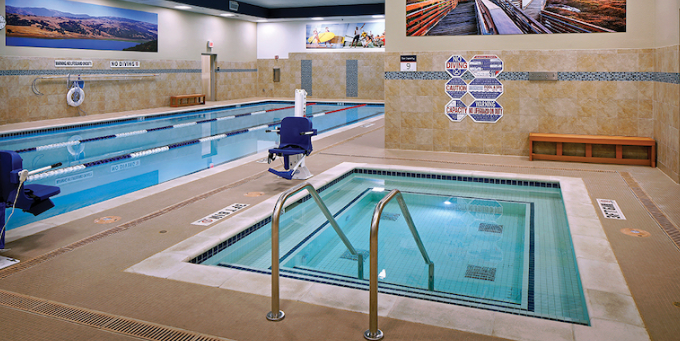Since the word “sauna” is Finnish, it is generally linked with Finland. Nonetheless, historical data indicates that they have existed in various societies for more than 2,000 years. These areas, frequently basic buildings with fireplaces or hot stones, originally acted as a refuge from the cold. Dry saunas are well known for their health effects these days. Heat causes sweating, which releases pollutants from the skin and relaxes tense muscles, promoting general well-being.
Spa accessibility has increased over time, thanks to innovations. John Harvey Kellogg created an electric bath using bulbs in the late 19th century, which was on display at the Chicago World’s Fair in 1893. When a Japanese physician invented infrared light for heating needs in the late 1970s, additional advances were made. Because of this invention, infrared spas are now just as common as conventional wood-fired or resistance heat spas.
Table of Contents
What are dry saunas, and how do they work?

Dry saunas use dry heat to raise the temperature in the chamber. A cooker that runs on gas, wood, or electricity and can reach temperatures between 70 and 100 degrees usually produces this heat. The low humidity promotes sweating, which helps to relax muscles and cleanse the skin. After taking a shower to wash off any chemicals that can prevent perspiration, people usually start their dry infrared experience.
After entering, visitors can relax on benches in the heat for ten to twenty minutes, with the temperature progressively rising as they get used to it. Towels are available for participants to use during a steam bath to remove sweat and encourage circulation. To avoid dehydration, you must take an additional shower to cool down after sauna therapy. It’s best to take a few minutes off before getting back to your routine.
Dry saunas are good for your health since they improve circulation, relax muscles, and help detoxify the skin. They are also believed to boost immunity and reduce stress. Those with certain medical issues, such as hypertension or cardiac disease, should consult a doctor before using a dry sauna.
Benefits of a Dry Sauna:
The benefits of a dry sauna are given below:
- Dry baths are quite hot.
- Heat aids in sweating and cleansing.
- It helps with muscle relaxation.
- Improves blood flow.
- Could reduce stress.
- It can enhance the health of the skin.
- Provides one with a feeling of well-being.
What are wet saunas, and how do they work?

Wet saunas, often known as steam thermal baths, use moist heat to produce a calming and revitalizing environment. These baths usually keep the temperature lower than dry bathrooms, typically between 110 and 120°F, but the humidity is almost always close to 100%. Water flows over hot rocks or a steam engine in a wet sauna, creating steam that fills the room and provides humidity and warmth.
Increased humidity helps to open pores and promote sweating, which helps the body rid itself of impurities. Wet spas are beneficial because of their moist heat, which helps to clear uptightness and coughing. The steam is also good for people with eczema or dry skin since it restores the skin. However, one has to realize that wet spas might not be appropriate for all individuals.
It can be difficult due to the high humidity, especially for people who have respiratory or heart problems. You must see a doctor before utilizing a wet bath, particularly if you have problems with your health. All things considered, for those who enjoy the damp warmth, wet baths provide a peaceful and revitalizing experience.
Benefits of a Wet Sauna:
The benefits of a wet sauna are given below:
- Reduces respiratory problems.
- Provides comfort in a moist setting.
- Encourages calmness and wellness.
- Moisturizes the skin.
- It helps the body rid itself of waste through sweating.
- Provides a calming encounter.
- Improves blood flow.
- Could release tense muscles.
- Helps in reducing tension.
- Maybe it increases immunity.
Dry sauna vs. wet sauna for weight loss
Increased sweating helps get rid of toxins and extra water weight. That’s why both wet baths (steam chambers) and dry spas can help you lose weight. However, weight reduction is mostly temporary and associated with fluid loss instead of fat loss. Dry baths usually run at higher temperatures and lower humidity, which encourages heavier perspiration. This may cause a greater rate of weight loss to occur during the session. Wet bathrooms, on the other hand, produce steam, which can also cause perspiration but might not feel as strong.
Dry Sauna vs. Wet Sauna: Differences
Humidity levels are the main difference between wet and dry saunas. The air in a dry sauna is as hot and dry as the sun in the desert, with very little moisture. On the other hand, the surroundings in a wet bath are similar to the rich moisture of a tropical jungle. Both varieties of baths cause sweating, although the effects depend on the humidity. Sweat clings to the skin in a wet bath because of the high humidity, which is similar to hot, steamy summer days.
In contrast, sweat evaporates quickly in a dry spa due to the low humidity, and it frequently builds on the body after some time in the heat. Furthermore, the two types of saunas have different rates of heating. It takes a few minutes for the heat to spread in dry saunas once the heater reaches its temperature. On the other hand, heat is quickly circulated in wet spas when water is poured over the rocks, producing steam instantly. One of the main draws for many people using wet baths is the quick introduction of steam heat.
Comparing Dry Sauna vs. Wet Sauna
Wet and dry saunas are the two most popular types of saunas, and they offer different experiences. The temperature, humidity, heating system, and building materials of these cabins will all be examined and contrasted in this section.
Temperature:
- The usual temperature range for dry saunas is 160°F to 200°F.
- Lower temperatures are maintained in wet spas, usually between 110°F and 120°F.
Humidity:
- Wet baths are significantly more humid than dry baths in terms of humidity.
- Steaming increases the level of humidity in the air during wet baths.
Heating Method:
- Heating elements are used in dry baths to provide air temperature.
- Steam generators generate steam for use as heat in wet cabins.
Material:
- Wood is frequently used in the construction of dry baths.
- Surfaces for wet saunas may include tiles or other non-porous surfaces.
Is a dry sauna or a wet sauna better for you?
It ultimately comes down to your tastes, whether you choose a wet or dry sauna. Both have specific benefits, so it’s important to think about your spa’s objectives. Examine the variety of heat settings available in spas to determine which one best meets your requirements. If you like really hot temperatures and enjoy the feeling of sweating out impurities, a dry cabin might be more your style.
On the other hand, a wet bath can be the best option if you prefer a more humid atmosphere and the feeling of dampness on your skin. Whichever option you select, staying hydrated and aware of your body’s signals are crucial. It’s critical to stop immediately and calm down if you start to feel uneasy or dizzy.
Tips for Selecting a Sauna

There are a few things to consider while choosing between a wet and dry cabin. To help you make a well-informed decision, consider these guidelines:
- Choose the heat type: Choose between dampness and dry heat. Wet spas use steam to generate a moist atmosphere, whereas dry spas use hot rocks or electric radiators to warm the air. Select it according to how hot you want it to be.
- Analyze Size: Keep in mind the space that your steam room will occupy. If you are in a tighter space, go for a smaller sauna; if you have more space, go for a larger one for ease of use.
- Put energy efficiency first. Search out baths that have highly efficient energy use. Selecting models featuring robust shielding and energy-efficient heaters can result in long-term cost savings on energy.
- Stress High-Quality Resources: Make sure that it is built with solid, moisture-resistant materials like hemlock or wood. High-quality materials improve the bathhouse’s efficacy and longevity.
- Investigate extra features: Examine any additional elements that could improve your hot tub experience. Built-in speakers, lighting, and additional seating and storage possibilities are features that some baths have. Determine the qualities that are most essential to you, and choose a spa based on those attributes.
Conclusion
The decision between dry and wet baths comes down to personal taste and health factors, but both offer many health advantages. A wet shower may help your respiratory issues because of its humid environment. On the other hand, a dry cabin can be attractive if you’re in the mood for extreme heat.
Put your health above all else by seeing a doctor before using a steam room, particularly if you have serious medical conditions. Keep in mind to drink enough water and keep clear of extended exposure to intense heat, as these can be dangerous. Enjoy the many advantages of this traditional practice while following safety precautions, regardless of your choice.
FAQs
The most frequently asked questions are given below:
What is the difference between a traditional sauna and a dry sauna?
Usually between 160 and 195 degrees Fahrenheit, dry baths are comparatively colder than other bathrooms, with humidity levels often between 10 and 20%. While wet baths are typically significantly drier—they can reach 100%—they are also typically cooler, around 90 to 120 degrees Fahrenheit.
Which type of sauna is better?
A conventional bathhouse can be the best option for you if you like steam, hotter settings, and a more sociable atmosphere. An infrared bath can be the ideal option for you if you like colder temperatures that nevertheless enter your body.
Are dry saunas hygienic?
Spas may stay relatively clean and won’t damage or infect people if they are utilized and maintained correctly. But when they are ignored or neglected for extended periods, saunas can turn into havens for ugly microorganisms.







